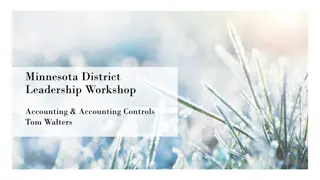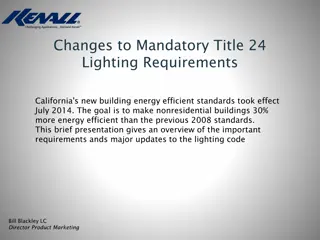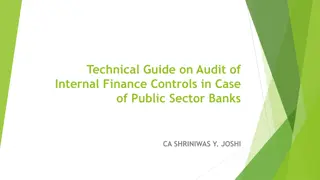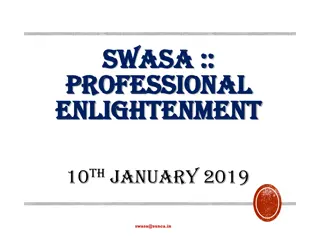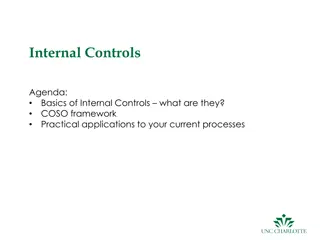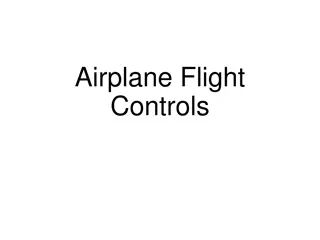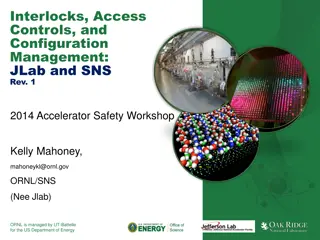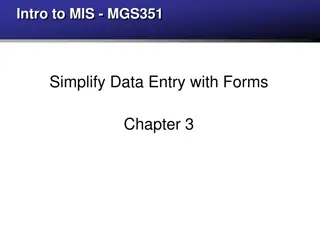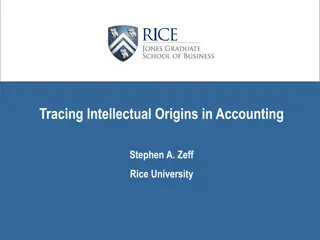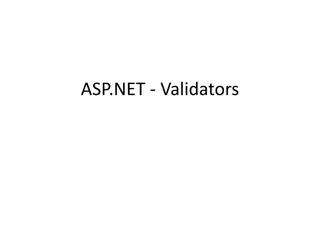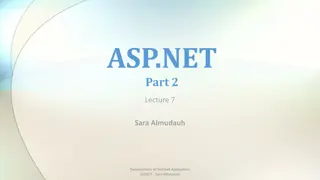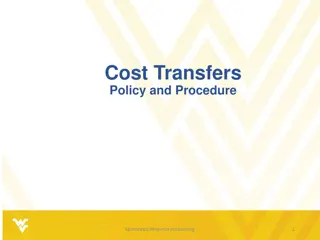Accounting and Accounting Controls Workshop Overview
This workshop led by Tom Walters covers the importance of accounting controls, including preventive, detective, and corrective measures. It delves into the types of controls needed in a congregational setting to safeguard cash receipts and disbursements effectively. Attendees will gain insights on maintaining financial accuracy and security in their organizations.
Download Presentation

Please find below an Image/Link to download the presentation.
The content on the website is provided AS IS for your information and personal use only. It may not be sold, licensed, or shared on other websites without obtaining consent from the author. Download presentation by click this link. If you encounter any issues during the download, it is possible that the publisher has removed the file from their server.
E N D
Presentation Transcript
Minnesota District Leadership Workshop Accounting & Accounting Controls Tom Walters
Introduction Missing Controls & Incompatible Duties Cash Receipts Controls Cash Disbursements Controls Financial Statements & Budgeting Soft Ware Solutions & Applications Financial Systems Reviews Reporting Functions Closing & Contacts AGENDA 2022 Accounting & Accounting Controls 2
Introduction Tom Walters Retired CPA Grant Thornton LLP - 39 years Audit Partner and Office Managing Partner Synod Involvement Chair of the Accounting Oversight Committee - Retired Martin Lutheran College Financial Advisor Governing Board Current Truth in Love Ministry Treasurer and Board Member - Current President of Christ Lutheran Church Eden Prairie (Founding member 1976) 2022 Accounting & Accounting Controls 3
Missing Controls & Incompatible Duties Missing Controls Types of Controls Preventive Controls Typical Preventative Controls in a congregational setting are designed to make certain that all cash receipts and cash disbursements are accurately safeguarded and properly recorded. These are the first line of defense controls to prevent loss and ensure accuracy. For church donations, sales, or other free will offerings, the cash and checks must be safe guarded from receipt through depositing at the bank by volunteers with no access to accounting records. Cash disbursements, almost always in the form of checks, must have proof of support and authorization, be signed by someone other than the person who prepared the check and the signor must review the supporting documentation before signing the check. Very high-level example of preventative controls. Detective Controls - Are meant to seek out unusual discrepancies that occurred during the execution of preventative controls that don't align with the policies and procedures in place. The goal here is to find any transactional processes that are not functioning as they ought to. For example, a month end bank reconciliation ties all bank statement information back to the accounting records and forces a perfect reconciliation of the cash account on the books with the bank statement is a detective control. Another detective control would be having your congregation s preventative controls review by another person(s). Corrective Controls - As the name suggests, corrective controls are put in place to fix any issues found through detective controls. These controls also include remedying any issues discovered in application of Detective controls in the accounting records after the detective control process has been completed. Preventative Controls Example 1. Requisition, 2. Purchase Order, 3. Receiving Report, 4. Accountant - Invoice, Match 1., 2., 3., with the Invoice and math check, 5. Check request, (1. 5. all require s/off) 6. Signor Reviews Check and all attachments and sign offs, 7.Signed Check send to vendor. 4 Accounting & Accounting Controls 2022
Missing Controls & Incompatible Duties Incompatible Duties Incompatible Duties arise in internal control systems because preventative controls (documented by a sign off that the control was performed) relies on separation of duties to reduce the chance of errors or fraud. Duties are incompatible if they should be separated for control purposes. For example, one person should not have authority to order a product, receive the product, receive the invoice, verify product receipt, prepare the check, sign the check, and send the check for the product. In this case all components of the purchase cycle were controlled by one person. Incompatible duties! The duties in bold above should be done by someone other than the bookkeeper. We usually need a minimum of three different people in this case: 1. Someone, other than the accountant, ordered or approved the order, and price, for the product and there is proof the product was received (visually, or other), 2. the accountant compares the invoice amount and the order amount, math checks the invoice and prepares a check for the proper amount. 3. the accountant delivers the check for signature along with the invoice and order/receipt documentation to the bank authorized check signor who examines the invoice and proof of order receipt and price, accompanying the check, comparing this data to the payee and amount on the check before signing it. (Accountant typically mails the check.) Accountants/Bookeepers should never be authorized check signers! 5 2022 Accounting & Accounting Controls
Cash Receipts Controls Collection Controls: Ushers take offering plates from the Alter and place it in a sealed envelope and then place in a safe. Offering Counters same day, or shortly after, a team of two unrelated counters retrieve the envelope and execute the count (see form) Counters create the deposit slip and make sure that the deposit slip and the Collection Worksheet are in agreement to the penny. Counters take the deposit to the bank and give the offering envelopes and the Collection Worksheet to the Bookkeeper who enters all the amounts into member s individual contribution records and the deposit amount into the general ledger bank accounts. Bookkeeper should double check the bank deposit by viewing the Church cash account online and confirm the total amount on the Collection Worksheet matches the actual amount recorded in the Church s account at the bank. Checks from other sources such as refunds for returned materials, rebates, etc., are given to the counters to include in their Collection Worksheet and bank deposit. The Bookkeeper should not directly deposit cash into the bank account or handle any live offerings if at all possible. Donations deposited should be classified as unrestricted (available for immediate use) or "restricted (restricted as to time or purpose). For example, you may have a member donate money to purchase a bus for the church this is purpose restricted; or another member donates a lump sum of money but asks it be spread evenly over the next five years this time restricted. Track these gifts separately in your records. Tuition, activity fees, concessions, etc. are non-deductible sources of income which need to be carefully controlled in a similar manner. (Churches, Schools, etc. can have credit cards but every purchase must have a receipt supporting the charge amount, which describes the purchase think of Costco for example. (No one should ever be allowed to open an account on behalf of the church without authorization.) 6 Accounting & Accounting Controls 2022
Cash Disbursements Controls Consider who can approve generating a purchase for example perhaps only the Council may be able to approve purchases over $1,000. All purchases and checks produced must be supported by some form of invoice or authorization independent of the bookkeeper. Exceptions small congregations communion wine, paper products, etc. (Use charge card) THE BOOKKEEPER SHOULD NEVER HAVE CHECK SIGNING RIGHTS. Check signers should be approved by the church council Always with signatures on file with the bank. For checks over $XX,XXX you may want two signatures. The Bookkeeper should math check all invoices and compare to purchase order documents. (Please initial invoices when math checking invoice and agreeing proof of receipt and purchase order when applicable.) The Bookkeeper should present the invoice, authority for order to the signor, together with the check in the amount of the invoice, and demonstrate the item purchased was received if requested. For example, a new piano the signer should see the piano, if a document doesn t demonstrate its delivery. The check signer should only sign checks when they are completely satisfied that the check amount, payee and supporting documentation all agree. Any concerns must be satisfied before signing the check. Take your time. The Finance Chairman (Treasurer) should review bank reconciliations periodically comparing ending cash balances to both the bank statements and the general ledger. Look for any items noted on the reconciliation beyond deposits in transit and outstanding checks. Sometimes there may be a bank fee or some other item. Fully understand bank fees and any other items. Then trace the book balance to the general ledger and to the monthly financial statement. (CLC s computer program performs our bank reconciliations from data inputted.) At least annually, it would be appropriate to review how the detailed general ledger cash receipts and expenses roll up into the financial statements line-item groupings. 7 Accounting & Accounting Controls 2022
Financial Statements & Budgeting Financial Statements Best Practices Accrual vs. Cash Basis Accrual accounting uses journal entries most accurate; Cash Basis reports cash transactions both acceptable methods (Accrual Accounting required for US companies, but many nonprofits use Cash Basis) Comparative Statements best practice present both current and prior comparative periods month/quarter and Year-to-Date Summarize to one page for Receipts & Disbursements and one page for Balance Sheet information (footnotes if necessary) Balance sheet minimum - List all cash accounts (grouped) their balance and purpose, mortgages and all debts Restricted cash - List or footnote restricted/designated gift accounts that have time or purpose restrictions Budgeting for Future Periods Prior to budgeting consider completing staff evaluations to assist in determining compensation adjustments Best practice is to prepare budgets at the account or line-item level then group for presentation Involve leaders from your Congregation s various operations Schools, day cares, etc. to determine changes they see occurring next year Review salaries against Synod Code (which is a suggested minimum compensation only) You can be above or below but Synod cannot Discuss your budget proposal with leaders of all areas of ministry balance expenditures against expected receipts (consider cash safety net) Present both actual financial results together with the planned budget to your congregation gather feedback modify as necessary Governing board/congregation adopts the budgeted expenditures for next period after addressing all feedback Consider tying strategic planning and budgeting together implement plans using the VTO (Vision Traction Organizer) which is available from Grace in Action 8 Accounting & Accounting Controls 2022
Software Solutions & Applications Bloomington Lutheran Living Hope - Churches & Schools (Budget over $2 million) Shelby Next ($860/month based on members) Modules: Membership, Financial, Online Giving (The Online giving application is easy to use and powerful each member can access their giving records, etc.) ADP ($320/month with 50+ employees) ADP is major US company - tremendous resources ADP solves issues - handles IRS filings Excel used when needed Budgeting, financial statements, etc. Truth in Love Ministry (Budget under $1 million) Quick Books ($400 annually) Best to have bookkeeping background, GL, Journal entries, Chart of Accounts, Bank rec. feature EZ Payroll ($120) Relatively easy, develops withholdings, prints checks, prints quarterly reports or can file electronically - 12 employees Donor Perfect ($4,000+/year) Online CRM data base, great search ability, requires training, volume-based fee 20,000 + contacts Excel Used for financial statement preparation, graphing, etc. Quick books loads general ledger into Excel Christ Lutheran Church (Budget under $300,000) Shepherds Staff ($499 to $1,000+ based on members) software on church computer (Church 360 is the online version) Concordia sponsors the software Shepherds Staff modules used: Attendance, Membership, Contributions, Financial (Applications: Financial: G/Ledger, Check register & writing, Payroll checks, Bank reconciliation, Journal entries, Balance Sheet and Statement of Operations capability) Excel Used for Payroll computation, and financial analysis, etc. Quarterly IRS reports and withholding prepared by hand 2 employees 9 Accounting & Accounting Controls 2022
Financial Systems Review If possible, from within your congregation identify an experienced Accountant or Bookkeeper to conduct an annual review of the accounting records and controls system. Without accounting training, it is difficult for untrained members to perform an annual accounting review. Some of the critical comments discussed earlier Missing Controls and Incompatible Duties are basically what you are testing/reviewing. The following are examples of some of the procedures you may want to perform when testing the accounting and reporting records: Cash Receipts Process - Trace actual deposits from bank statements to the duplicate deposit forms and the Count Worksheet; Select individual donations and track to donation records; on a test basis examine restricted cash account transactions back to relevant documents that established the time or purpose restriction, and who, along with the amount, contributed to the restricted account; determine other procedures based on processes used at your congregation. Select deposits recorded in the general ledger and trace them back to the bank statement, compare amounts on the detailed duplicate deposit ticket to individual donor records on a test basis. Cash Disbursements Process - Select disbursement transactions from the bank statement and trace the check number and amount, back to a copy of the check, and the related invoice or supporting documentation; determine who authorized the purchase, is their proof of receipt showing it was delivered to your church, did an authorized signor sign the check, is there any evidence or initials evidencing their review. Next select disbursements from the check register or entries in the general ledger and trace them to their supporting documents as previously described. Next, from within the vendor filing system select several vendors and examine the supporting documentation for three or four invoices in each file. Examine voided checks and test check number sequence in the cash disbursements ledger (account for all check number sequences in one or two month). Examine unused checks and check number sequence randomly, and are they safely stored. Payroll - Examine payroll records, determine if the accounting records have the proper number of pay periods, look at the withholding amounts and randomly trace withholding to checks which were sent to Fed, and State, examine bank cleared supporting checks and filing documents. Recompute net check from gross pay, less w/holdings in the payroll records to test amounts. Trace several checks to bank statements and from bank statements to returned checks. Determine that salaries paid, or hourly rates, were approved by council or compensation committee. Trace payroll records tested into the general ledger accounts. Test bookkeeper s pay checks for accuracy and trace to ledger records. Examine personnel files for the bookkeeper and several others, if the exist. Look for anything usual related to compensation. Did payroll stop when an employee left the church/school? Etc. 10 Accounting & Accounting Controls 2022
Financial Systems Review - Continued Additional Accounting Records to Test General Journal Entries - Journal entries can be used to conceal fraud (but fraud is also extremely rare). Journal entry review must be performed by an accountant. A. The typical review would have procedures such as the following examples: A. Select one or two months and carefully look through all the journal entries. Pay special attention to any entries involving cash accounts and gain an understanding of why the entry was made and examine support of the entry the bookkeeper can walk through the support for entries. B. Look for entries that impact balance sheet accounts only, or impact expense accounts only. These should be very rare. C. Trace entries into the general ledger accounts examining the relevant accounts to see the entry was posted correctly. Trace random journal entries in the general ledger back to the journal entry books. Look at correcting journal entries, standard monthly entries, end of month entries to accrue expenses or report revenues, and determine that those entries were properly reversed at the beginning of the next month/period. Examine entries impacting restricted cash accounts. General Ledger - Select one or more months and test trace general ledger accounts into the financial statements. Often several accounts are grouped. Examine the groupings and determine if they are consistent with the description on the line in the financial statements where the balances are reported. You can go both ways in this process from the statements to the ledger and the other direction. Financial Reports - High level overview of financial statement presentation is contained on page 8 hereof. However, in reviewing comparative financial statements accountants are taught to examine material changes up or down on each line item. Why is it different this year compared to the prior year or monthly period? Evaluate explanation and investigate (look at invoices or other documentation) as determined necessary. You can math test the statements or test the formulas used in the Excel spreadsheets. General Review - Examine new relationships or contracts for material new services. Examine an organization chart, interview the Treasure and include the Treasure in your review. Be curious, never be afraid to ask the bookkeeper to show you how something was handled and look for proper segregation of duties or incompatible duties. Accounting & Accounting Controls 11 2022
Conclusions Reviewing accounting records and internal controls involves risk assessment skills and attention to details. So, one last time experienced accountants are best positioned to assist with the matters presented to you today. You are welcome to contact me with questions related to the presentation today. Tom Walters Email: tcwalters@tcwalters.com Cell: 612-868-7046 May the Living Lord bless your work on behalf of His kingdom! 2022 Accounting & Accounting Controls 12






